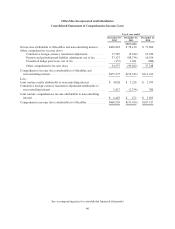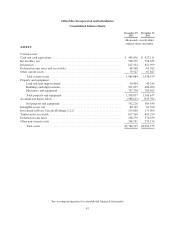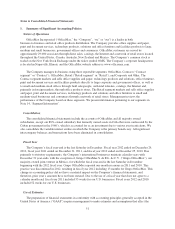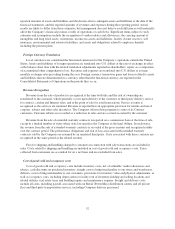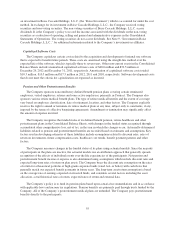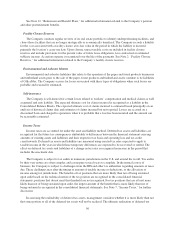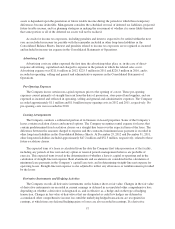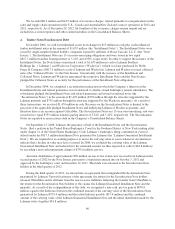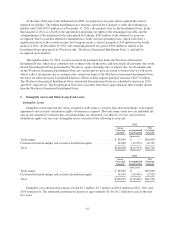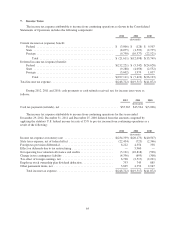OfficeMax 2012 Annual Report Download - page 90
Download and view the complete annual report
Please find page 90 of the 2012 OfficeMax annual report below. You can navigate through the pages in the report by either clicking on the pages listed below, or by using the keyword search tool below to find specific information within the annual report.Merchandise Inventories
Inventories consist of office products merchandise and are stated at the lower of weighted average cost or
net realizable value. The Company estimates the realizable value of inventory using assumptions about future
demand, market conditions and product obsolescence. If the estimated realizable value is less than cost, the
inventory value is reduced to its estimated realizable value.
Throughout the year, the Company performs physical inventory counts at a significant number of our
locations. For periods subsequent to each location’s last physical inventory count, an allowance for estimated
shrinkage is provided based on historical shrinkage results and current business trends.
Property and Equipment
Property and equipment are recorded at cost. The Company calculates depreciation using the straight-line
method over the estimated useful lives of the assets or the terms of the related leases. The estimated useful lives
of depreciable assets are generally as follows: building and improvements, three to 40 years; machinery and
equipment, which also include delivery trucks, furniture and office and computer equipment, three to 15 years.
Leasehold improvements are reported as building and improvements and are typically amortized over the lesser
of the term of the lease or the estimated lives of the improvements, which generally range from two to 20 years.
Long-Lived Assets Impairment
Long-lived assets, such as property, leasehold improvements, equipment and capitalized software costs, are
reviewed for impairment whenever events or changes in circumstances indicate that the carrying amount of an
asset may not be recoverable. Recoverability of assets to be held and used is measured by a comparison of the
carrying amount of an asset to the estimated undiscounted future cash flows expected to be generated by the
asset. If the carrying amount of an asset exceeds its estimated future cash flows, an impairment charge is
recognized equal to the amount by which the carrying amount of the asset exceeds the fair value of the asset,
which is estimated based on discounted cash flows. In 2012, 2011 and 2010 the Company determined that there
were indicators of impairment, completed tests for impairment and recorded impairment of assets of individual
retail stores, which consist primarily of leasehold improvements and fixtures. See Note 5, “Intangible Assets and
Other Long-lived Assets,” for further discussion regarding impairment of long-lived assets.
Intangible Assets Impairment
Intangible assets represent the values assigned to trade names, customer lists and relationships and exclusive
distribution rights of businesses acquired. Intangible assets with definite lives, which would include our customer
lists and relationships and exclusive distribution rights of businesses acquired, are amortized over those lives and
are reviewed for impairment in the same manner as long-lived assets discussed above. Intangible assets with
indefinite lives, which would include our trade name assets, are not amortized but are tested for impairment at
least annually, or more frequently if events and circumstances indicate that the asset might be impaired.
Beginning in 2012, we may make a qualitative assessment to determine whether it is more likely than not that an
indefinite-lived intangible asset, other than goodwill, is impaired. If, after making the qualitative assessment, we
determine it is not more likely than not that the fair value of an indefinite-lived intangible asset is less than its
carrying amount, then performing a quantitative impairment test is unnecessary. If a quantitative impairment test
is performed, the asset’s fair value is estimated and compared to its carrying value. An impairment loss is
recognized to the extent that the carrying amount exceeds the asset’s fair value. At the end of 2012, 2011 2010,
we performed quantitative impairment tests of our trade name assets and no impairment was recorded as a result.
Investment in Boise Cascade Holdings, L.L.C.
Investments in other companies are accounted for under the cost method, if the Company does not exercise
significant influence over the other company. At December 29, 2012 and December 31, 2011, the Company held
54




